According to a World Bank survey, 78% of Nigerians connected to the grid receive less than 12 hours of electricity daily.
The Nigerian government tried to refute the survey results, stating that only 55% of Nigerians were in Bands D and E of the service bands, which means they are only obligated to get 8 and 4 hours of electricity daily. But, while this is true, it’s been difficult for the power sector to meet its supply obligations to customers following five grid collapses this year alone and generation shortages.
Key takeaways
-
The energy situation in the country has gotten a lot worse this year with regular grid collapses, petrol shortages and skyrocketing diesel prices.
-
As a result, Nigerians are on the lookout for off-grid alternatives, and one alternative that’s gaining popularity is the solar inverter system.
- Thankfully, the technology has evolved and become more efficient. Also, energy startups are
For many Nigerians, the alternative is self-generation. I was talking to my Ugandan colleague the other day, and he asked me if it was true that most Nigerians had generators. It was funny but a little sad at the same time when I answered that every Nigerian and their neighbour who could afford it had at least one diesel or petrol generator. According to the World Bank enterprise survey, Nigerians with generators derived 58.8% of their electricity from their backup generators on average despite also having grid access. For Ugandans, this figure was just 17.6%.
But, one thing that hasn’t been funny this year is the energy crisis we’ve been experiencing. First, it was petrol—the NNPC imported contaminated petrol, and the Russia-Ukraine war made it difficult to get new supplies. This led to a fuel scarcity situation that lasted over a month. Around the same time, the available electricity generation dropped, leading to nationwide blackouts, no thanks to gas shortages. And still, within the same period, diesel prices tripled from about ₦200 to over ₦700 per litre. Nigerians haven’t been able to catch a break this year; it’s been one energy issue after another.
However, another energy alternative is gaining popularity with Nigerians, given that our petrol or diesel generators and the grid have failed us. Inverter systems are a viable alternative, with some users even going entirely off-grid, leaving the grid’s headaches behind.
What are inverter systems?
An inverter is just a component of what we call a solar inverter system. According to the CEO of Eiry Energy, the inverter is like a water tap, and on its own, it’s almost useless.
The system comprises a power source, batteries, and an inverter. The power source, which could be solar energy or electricity from the grid or your generator, charges the battery. Then, the inverter converts the battery power, which is direct current electricity, to alternating current electricity that we can use to power our homes and businesses.
Today, inverter systems are a lot different than they were five to ten years ago. For one, the batteries are a lot more sophisticated. Modern inverter systems use lithium batteries which have a longer life span and are more energy-efficient. For people who owned inverters back then, inverter batteries were lead-acid batteries and would only last about three years. But, lithium batteries last as long as five to ten years, depending on how they’re used and maintained. So, a lead-acid battery inverter would only power a few light bulbs, fans and charge phones or laptops, similar to the MTN Lumos solution. Now, there are inverter systems that can power ACs and kettles, depending on the capacity of the systems.
Another plus is that inverter systems can be solar powered. Most people have hybrid systems with batteries that can be charged with solar energy from the sun or electricity from the grid or generator when they’re available. Another plus is that solar panels can last over 20 years, and the inverters can last up to ten years. When fully charged, inverter systems can last for up to ten hours a day and even more, depending on how energy efficient a user is. If there was a grid collapse or your generator stopped working suddenly, you wouldn’t be left in the dark.
These are good reasons why anyone would want an inverter system: they have long lifespans, they provide electricity for hours, they can be solar-powered, and unlike your generator, you’re free from polluting fumes and noises.
But, it’s not so easy for everyone to have one.
Who are inverters for?
The first thing to note about solar-powered inverter systems is that solar panels take up space. The more energy you need, the more solar panels are required, and the more space to mount the panels.
Solar panels could easily be mounted on the roof for residential or small business users. But for businesses that consume a lot of electricity, more space is required to mount the solar panels, which could mean finding unoccupied plots of land. If you’re a business owner in Lagos, even if you were able to find land, the cost of the land would probably be too high to be commercially feasible. In addition to the land, the cost of the system itself can be pretty expensive.
Kunle* owns a chain of restaurants on the outskirts of Lagos. When diesel prices shot up and the grid issues caused a three-week blackout, running a diesel generator for 18 hours a day became unsustainable in no time. So, he got in touch with a solar inverter installation startup to install an inverter system at one of the restaurants. There were two significant issues—the space constraint and the cost of the system. The quote he got was $250,000 (over ₦125 million) for just one restaurant. Kunle was forced to reconsider and source smaller diesel generators that consume fewer litres per hour. They also became more conscious of their energy use and what appliances they decided to run.
You see, the larger the user’s electricity use, the more expensive the inverter system and the more space required for installing solar panels. In addition, there’s a limit to how cost-efficient an inverter system can be, especially when your building requires a lot of energy.
But, solar inverter systems work for residential users and small businesses. Despite deciding against installing an inverter system at his restaurant, Kunle still wanted an inverter system for his home. Living in Lekki, a residential area in Lagos, Kunle was tired of dealing with spotty electricity from the grid and running his generator all the time just to have constant electricity. For many Nigerians, stable electricity is a luxury that’s become even more expensive with higher electricity tariffs (despite incessant outages) and high diesel prices. In a month, Kunle was spending about ₦50,000 on grid electricity and ₦70,000 on diesel—₦120,000 every month just on electricity. This is in a country where 27.4 million Nigerians earn less than ₦100,000 per annum. It’s clear that reliable electricity is a luxury good for many Nigerians, and this means that demand can only grow when there’s an increase in income.
Kunle went ahead to get quotes for a solar inverter system. He wanted one that could power his light bulbs, TV, fridge, air conditioners and most of the appliances in his house. But, the bill was about ₦3 million. One of the reasons why the price was so high is due to currency devaluations, given that these inverter systems are imported. A few years ago, it would have been cheaper. In the past four years, the value of the naira relative to the dollar has declined by over 57%, from about ₦363 in 2018 to over ₦570 in 2022. While the inverter startup offered a payment plan where he could pay ₦300,000 upfront and pay monthly instalments of about ₦100,000, Kunle decided to go with a smaller, more affordable system from another startup.
Uwana energy had smaller inverter systems that could power Kunle’s home office, including his fan, TV, printer, lightbulbs and charge multiple laptops and phones. The solar inverter systems had everything except the solar panels in one box. And the cost was ₦320,000. So, Kunle could work comfortably from his home office during the day and switch to his generator at night, also charging the inverter system. Now, Kunle is practically living off-grid because with his inverter on during the day, lasting for over 10 hours, there’s no need to switch to grid energy during the day, especially with the constant outages. With the inverter being solar-powered, it can charge during the day. And at night, Kunle runs his diesel generator if there’s no grid electricity available. While the inverter system cost ₦320,000, with over ₦50,000 monthly savings on electricity bills and running his diesel generator less, it’s been a worthwhile investment.
According to the COO and Co-founder of Uwana energy, Tayo Oyinlola, the inverter system packs a punch despite its relatively low cost and small size. With a lithium-ion battery, the inverter system is cost and energy-efficient. At peak sunlight in Lagos of three to five hours to charge the battery, the inverter system can last more than eight hours before running down. And with proper energy management (meaning appliances are turned off when they’re not in use and energy-saving light bulbs and appliances are used), an inverter system could even last longer. A bonus is that you can charge an inverter with electricity from the grid or a generator.
And, it’s not just Kunle that’s switching to inverter use. According to Tayo, the energy situation in the country has dramatically increased the demand for their ₦320,000 solar inverter systems. Now, there’s even a waiting list while they await delivery of new systems. For Tayo, his startup had a marketing strategy rolled out this year to increase sales. But, they did not anticipate the level of demand they got. To make the product more accessible, Uwana energy has partnered with some fintechs to offer Buy Now Pay Later (BNPL) payment models. This allows customers to buy solar inverters on credit. The partner fintechs pay Uwana energy the total amount while recovering their money in instalments from the customer over a maximum period of one year.
Renewable energy companies recognise that one of the most significant barriers is the cost and have become increasingly innovative in offering embedded finance to customers. According to a survey by Briter Bridges on the state of fintechs in emerging markets, 10.1% of fintech startups provide embedded finance solutions for energy startups. Embedded finance is so essential that startups like M-kopa regard themselves as asset financing companies that happen to offer energy assets to users.

While the space and cost constraints of solar inverter use still exist for larger commercial users, inverter systems could be one solution to the energy needs of residential users and small businesses. And, soon, a more significant number of Nigerians could go entirely off-grid.
Off-grid is the future
In a previous story, we established that Nigerians shouldn’t hold their breath waiting for the grid’s issues to be fixed.
Rural and peri-urban dwelling Nigerians without grid access have realised this and are accepting off-grid solutions like mini-grids and solar home systems. Before the current energy crisis, urban-dwelling Nigerians could make do with the spotty grid since they had backup generators. But, the diesel prices and petrol shortages exposed how precarious that balance was.
As the technology becomes more sophisticated and energy startups continue to address affordability barriers, more Nigerians will turn away from the grid. And with electricity tariffs being as high as ₦65/kWh, it’s making less and less sense to continue paying so much for such lousy service.
Essentially, the future of Nigeria’s electricity is off-grid, and soon enough, we will all jump on the off-grid bandwagon.
*Kunle’s name has been changed to protect their identity



